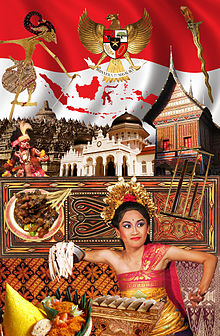This article has multiple issues. Please help improve it or discuss these issues on the talk page. (Learn how and when to remove these messages)
|
| Part of a series on the |
| Culture of Indonesia |
|---|
 |
| People |
| Languages |
| Mythology and folklore |
| Cuisine |
| Literature |
| Music and performing arts |
| Sport |

Television in Indonesia started in 1962 (during the opening ceremony of the 1962 Asian Games), when the then state-run station TVRI began broadcasting – the third country in Southeast Asia to do so. TVRI held a television monopoly in Indonesia until 1989 when the first commercial station, RCTI began as a local station and was subsequently granted a national license a year later. The Indonesian television is regulated by both Ministry of Communications and Informatics (Kemenkominfo) for frequency matters and Indonesian Broadcasting Commission (KPI) for content matters.
Each of the networks have a wide variety of programmes, ranging from traditional shows, such as wayang performances, to Western-based programmes such as Indonesian Idol, Family Feud, MasterChef, Top Model and The Voice. One typical television show common to almost every network is sinetron[1] Sinetron is usually a drama series, following the soap opera format, but can also refer to any fictional series. Sometimes it can be comedic, like the popular Bajaj Bajuri series, featuring a bajaj driver and the people he drives around.
There are a number of awards given for excellences in Indonesian television, notably Panasonic Gobel Awards (defunct) and Indonesian Television Awards (since 2016), as well as Anugerah KPI held by the KPI.
- ^ Sinetron is an abbreviation from an Indonesian phrase denoting "electronic cinema".